by Craig McClenachan, Vice President, Advanced Assembly, Fabrico
Structural adhesives, in both liquid and tape formats, are assuming a more important role in a number of industries as replacements for mechanical fasteners. Here’s what you need to know to apply these adhesives.
In the North American transportation industry, including automotive and aerospace, structural adhesives are a $1.2 billion dollar market, projected to grow 3 to 4% annually. As CAFE (Corporate Average Fuel Economy) regulations for 2020 loom, the replacement of metal parts with plastic and composite material is also driving adoption of structural adhesives in transportation applications. CAFE standards mandate that vehicles attain an average of 35 miles-per-gallon by 2020.
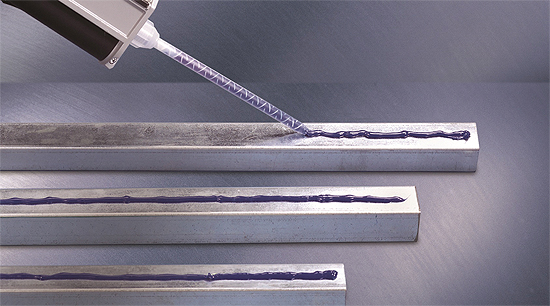
Structural adhesives can fill large gaps between substrates, and provide a seal against corrosion and environmental extremes.
In 2010, industry analysts valued the U.S. adhesives industry at $11 billion, with a CAGR of 4%. The largest areas for ongoing growth appear to be in pressure-sensitive adhesives, where the estimated growth rate is 17%, and structural adhesives, where growth is expected to be 9%.
Displacement of mechanical fasteners has been going on for many years; they are labor intensive and often more expensive than adhesives. Although there are some applications that may never use structural adhesives, it’s estimated that 68 lb of adhesives have replaced 201 lb of mechanical fasteners in the average vehicle in recent years. In aerospace, in 1972 the Airbus A300 used 1% composites and 5% titanium. The new Boeing 787 uses 50% composites and 15% titanium, increasing the use of adhesives to bond these materials.
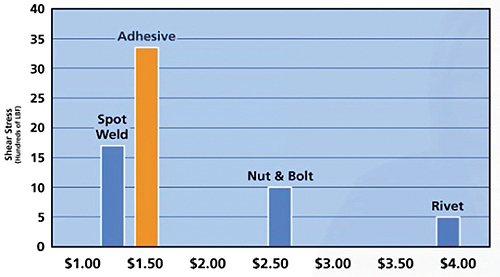
Structural adhesives are lower in cost than many labor intensive mechanical fastening technologies such as welding, rivets, or nuts and bolts.
Structural adhesives can now be found in a range of industries, including transportation, construction, product assembly, medical device manufacturing, electrical and electronics, and defense. Within these industries, applications can include flanges for doors and enclosures; window/glass attachment; attachment of components; bonding of dissimilar substrates; body/rigid panel attachment; and engine components where vibration absorption is critical.
Trends affecting the adoption of structural adhesives
Design engineers have many reasons to replace mechanical fasteners with adhesives, including
- Higher energy costs pushing weight reduction and fuel efficiency;
- Manufacturers wanting to reduce costs, reduce the number of components in an assembly, and improve productivity;
- Manufacturers looking to improve product quality by eliminating process variables;
- Design engineers working with dissimilar materials such as plastics, composites, and new metal alloys;
- Components becoming smaller and lighter with less space in the design for mechanical fasteners and less space on the manufacturing floor for mechanical fastening processes;
- Manufacturers automating more processes, with structural adhesives more adaptable to automated processes.
Advantages of structural adhesives
Structural adhesives are generally defined as “load-bearing” adhesives. Depending on the application, they can withstand heavy loads to 4,000 psi or even higher. Regardless of the application, a structural adhesive won’t fail when a bonded joint is stressed to its yield point. Structural adhesives are part of the structure of their assemblies; they are designed to meet the performance specifications of the entire assembly.
Structural adhesives can include acrylics, epoxies, and urethanes.
Acrylics are formulated to provide good adhesion with metal, composites, and thermoplastics. In general, they are fast setting and curing, and offer significant productivity gains.
Epoxies provide excellent adhesion to metals and rigid substrates that include thermoset plastics and composites. Epoxies are known for durability, chemical and temperature resistance, and low shrinkage.
Urethanes and polyurethanes are suitable for use with thermoplastics; because of their flexibility, they work well with softer, less rigid materials.
Using structural adhesives instead of mechanical fasteners lets you assemble dissimilar materials with higher weight loads and distribute stress evenly across the bond. Structural adhesives won’t negatively affect the integrity and strength of the materials – there are no holes, rivets, or other mechanical fasteners to weaken the structure of the joined materials. Structural adhesives also result in a more aesthetically pleasing design, an important criteria in many industries, including automotive, medical equipment, and appliance. In addition, structural adhesives can fill large gaps between substrates and seal joints against corrosion and environmental extremes. They are also easily integrated into automated manufacturing processes, letting you explore new designs and maximize the use of new materials.

It is estimated that 68 lb of adhesives have replaced 201 lb of mechanical fasteners in the average vehicle in recent years, for applications including door and panel attachment and engine components.
In one application, a trade-show display manufacturer was looking for a light weight, durable solution to bond aluminum hinges to polypropylene panels. The bonds needed to stand up to extreme shipping and handling conditions and heavy use. We suggested and tested structural adhesives that offered advantages in bond strength and allowed for joining of dissimilar materials – requirements that traditional mechanical joining methods are not able to accommodate.
Perhaps the greatest advantage of structural adhesives is cost. These adhesives are lower in cost than labor intensive mechanical fastening technologies like welding, rivets, screws, or nuts and bolts.
Of course, structural adhesives are not appropriate for every application. They require time to cure and fixture, application can be messy, they must be properly handled, and they can sometimes be difficult to assemble.
Designing effective bond joints
Bonded joints have four main loading modes:
- Peel loads produced by out-of-plane loads acting on thin substrates;
- Shear stresses produced by tensile, torsional, or pure shear loads on substrates;
- Tensile stresses produced by out-of-plane tensile loads;
- Cleavage loads produced by out-of-plane tensile loads acting on rigid and thick substrates at the end of the joint;
- Good joint design for substrates and structural adhesives maximizes tension, compression and shear, minimizes peel and cleavage, and increases the bond area – wider is better.
The aim is to design a joint that maintains the adhesive in a state of shear or compression, since bonded joints are strongest under these conditions. Avoid or at least minimize tension, cleavage, and peel forces. The presence of stresses compromises joint strength and fatigue resistance. It is important to ensure that the adhesive is not the weakest link in the bond. Structural adhesives are known for their relatively poor resistance to peel stresses, and to obtain maximum bond efficiency joints must be designed to minimize tensile stresses. Potential failure modes for structural adhesives bonding metallic or composite joints include:
- Tensile, compressive, or shear failure of the adherents;
- Shear or peel in the adhesive;
- Shear or peel in a composite near surface plies;
- Shear or peel in the resin-rich layer on the composite’s surface;
- Adhesive failure at the metal/adhesive or composite/adhesive interface.
Adhesive failure is a rupture of the adhesive bond, separating the adhesive from the adherend (substrate). Adhesive failure can also be called interfacial failure. Cohesive failure of the adhesive occurs when the load exceeds the inherent adhesive strength. Cohesive failure of the adhered (substrate) occurs when the load exceeds the adherend strength.
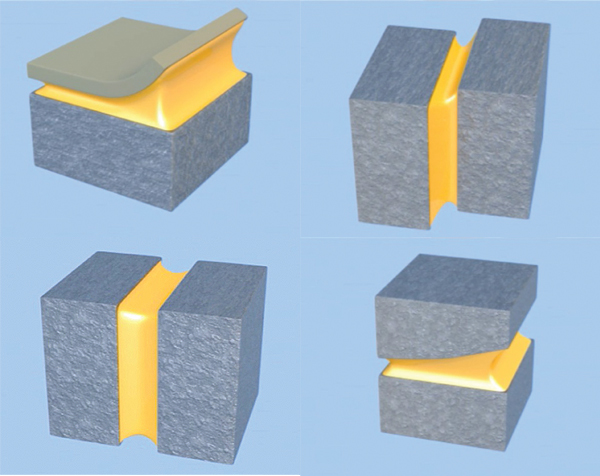
Good joint design for substrates and structural adhesives maximizes tension, compression, and shear, minimizes peel and cleavage, and increases the bond area – wider is better.
Good bond joint design is critical to the successful use of structural adhesives. Joint designs can include: lap/overlap, double lap, butt joint, scarf joint, strap or double strap joint, and a cylindrical joint. The joint design should increase bond strength. Butt joints are best used when stresses are concentrated along the bond line and perpendicular forces are minimal. Scarf joints are useful for close-fitting parts that allow a large contact area. Lap and offset lap joints are well suited for bonding thin, cross-sectional, rigid parts. In lap joints, the bonded parts are slightly offset.
When working with liquid adhesives, a smooth and consistent bead is important to ensure a good bond. Too much or too little adhesive introduces inconsistencies and potential problems. With tape systems, using the right amount of pressure is critical to ensure that the tape adheres completely and fills in any gaps between materials, especially between machined materials.
The role of the converter
As the use of structural adhesives grows, manufacturers are looking to partner with converters who can help them select the best structural adhesives and materials for their application and manufacturing process. An experienced converter can:
- Analyze the application for materials and adhesive requirements;
- Recommend materials and adhesives and suppliers;
- Test the materials and adhesives;
- Develop prototypes for customer testing;
- Provide design-for-manufacturability.
A converter should offer full integration with the customer’s engineering, including 2D and 3D CAD design capabilities, integration of the customer’s electronic drawings, and rapid prototyping capabilities for thorough design vetting before manufacturing.
In addition, the converter should be able to qualify materials and adhesives based on in-house laboratory testing:
- Temperature resistance;
- Performance at upper temperature limits;
- Shear, tensile, and peel strength;
- Outgassing;
- Dielectric strength and electrical conductivity;
- Thermal conductivity;
- Slitting widths and tolerances.
For structural pressure-sensitive and other tapes, the converter must offer precision die-cutting using rotary or laser technology, water jet cutting, and die-less cutting. In addition, precision slitting and rewinding, laminating, and printing are also critical capabilities.
For liquids, a converter must be able to provide packaging/repackaging to fit the customer’s manufacturing process, including:
- Tubes, cartridges, cans, and bottles;
- Single- and dual-component cartridges;
- Custom blending of fluids, fillers, and solvents;
- Precise pre-mix, pore-measure, and air-free materials;
- Liquid dispensing systems;
- Dispensing and curing equipment and supplies;
- Assembling, kitting, and custom packaging.
Fabrico
www.fabrico.com


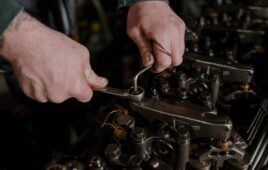

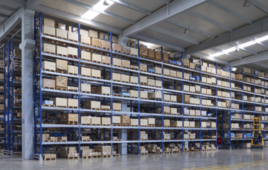
For gluing sheet metal together, which adhesives can survive a powder paint process?
Powder coating processes involve a heat bake operation of 180-220 degrees Celsius (356-428F) for a 10-15 minute bake cycle. The better 2 part structural adhesives out there can usually handle 250F short term and about 180F long term. As a rule of thumb, I would eliminate them from the evaluation. There are structural options like 1 part aerospace adhesives, but the cost and equipment would probably be prohibitive here. I would suggest going down a different path and use a 3M 4611 VHB tape. This acrylic tape can handle the process and provide a strong bond. If you have any additional questions, please feel free to use the ‘Ask an Engineer’ form on the Fabrico website: http://www.fabrico.com/ask-an-engineer.htm.
Powder coating processes involve a heat bake operation of 180-220 degrees Celsius (356-428F) for a 10-15 minute bake cycle. The better 2 part structural adhesives out there can usually handle 250F short term and about 180F long term. As a rule of thumb, I would eliminate them from the evaluation. There are structural options like 1 part aerospace adhesives, but the cost and equipment would probably be prohibitive here. I would suggest going down a different path and use a 3M 4611 VHB tape. This acrylic tape can handle the process and provide a strong bond. If you have any additional questions, please feel free to use the ‘Ask an Engineer’ form on the Fabrico website: http://www.fabrico.com/ask-an-engineer.htm.